Galway Castle
HTNG
GALWAY CASTLE was built in 1911 by Harland & Wolff at Belfast with a tonnage of 7988grt, a length of 452ft 4in, a beam of 54ft 4in and a service speed of 13 knots.
Similar to the Grantully Castle she was the last ship to be delivered before the company was taken over by Royal Mail. In August 1914 she was requisitioned as a troop ship for deployment in the German West Africa campaign against Windhoek.
After the German colony was taken over by General Botha in 1915 she reverted to commercial service as the only remaining Union-Castle vessel. On 3rd August 1916 she was attacked by a German bomber near the Gull lightship but the bomb, although scoring a direct hit, failed to explode.
She went aground on the Orient Bank at East London on 12th October 1917 but was refloated five days later without any damage. .
From Union-Castle, A Fleet History by Peter Newall :-
150 lives were lost, many unnecessarily during the evacuation of the ship, which although suffering a broken back, remained afloat for another three days.
I rarely comment upon statements made either by 'shipmates' or authors of articles in books. One very noticeable feature of almost every book published about the Union-Castle Line is that very few were been written by a professional mariner. Thus sweeping statements such as the above by Peter Newall and lives lost during the abandonment of the "Galway Castle" remain unchallenged, and appear to cast a question mark over the decisions made by an exemplary master. In his book Marischal Murray gives a rather more accurate description of the abandonment but, significantly makes no mention of the master's skill.
It does not require an "A" level in mathematics to work out that, with some one thousand on board each of the eighteen boats launched had to take an average of fifty-six people. I cannot give the exact dimensions of the "Galway" lifeboats but I can assure you that each boat must have been packed tighter than a can of sardines. That this situation prevails to this day I refer you to Captain Norman Lloyd and his demonstration of the loading of a "Transvaal Castle" lifeboat. The simple fact is that lifeboat capacity is a purely arbitrary figure arrived at by allocating each person so much cubic space, how you actually get so many into a boat is completely another matter. The fact is that, unless the "Galway Castle" was carrying additional lifeboats to those shown in all photographs, her lifeboat capacity fell well short of what was required.
This one simple fact must have been uppermost in Captain Dyer's mind that day. The "Galway Castle" had just passed through severe weather, even if the wind had dropped to light airs the swell would still have been a significant factor to a disabled vessel wallowing without means of manoeuvre. It was daylight, the weather may well deteriorate, Captain Dyer had not the benefit of today's weather forecasting and facsimile weather maps, he could not even communicate with anyone for advice, it was his decision and his alone. (This is as true today as then. When through a series of mishaps and blunders I found myself in mid Atlantic with just 15 tons of fresh water remaining and the ability to make only about 5 tons a day, I was told precisely that by my company manager. If I put into the Azores to take water I would jeopardise the charter, by shutting off all crew consumption and issuing mineral water for drinking I could just make I calculated Kingston in Jamaica. Had for instance we suffered a further problem with the boiler that required 20 tons to fill up it would, as I put it to my superintendent, be a tow job. As it was we made Kingston and the company said what a clever master I was, had I not then I would have been relieved of my ship at the next opportunity.)
So Captain Dyer, he of course could not actually see the damage to the ship, he only new that it was so serious that she would, if conditions deteriorated most probably break up, indeed she was giving every indication that she was in fact breaking up then. It was poor training and indecision that finally resulted in the "Titanic" shambles. Captain Dyer must also have been very conscious of Captain Edward Manning, master of the "Teuton" in 1881, and his over confidence in the strength of his ship with its catastrophic consequences. Thus his order to abandon ship whilst conditions were if not good at least acceptable was without any question the correct one.
Very few authors of marine books actually know how lifeboats are lowered, even with all the modern technology there are still fatalities - and those have been at lifeboat drill in port! The lifeboats of the "Galway Castle" were hung in very similar davits to the company's cargo ships. Housed, the boat sat on wooden chocks. To lower the boat the davits had be wound out (manually) to put the lifeboat over the ship's side, but first the gripes, wires securing the boat to the deck and davit would be released. and the very heavy wooden boat had now to be lifted off the chock. This was done by attaching a 'handy-billy' to the down-haul part of the boat falls (either a two or three fold purchase). Hauling on the handy-billy, lifting the boat (this had to be done at each end of the boat simultaneously) and, taking up the resulting slack on the falls down-haul and securing round the lowering stag-horns on deck. The boat was then ready to be swung out. To lower each boat required three very well trained men, the person in charge had to stand midway between each lowering stag-horn, each one manned. The operation of winding the davits out was a heavy one, initially until past the absolute upright position it required two men to each handle, turning on a thread the davit. Past the upright and the opposite tended to be the case, the boats weight threatening to run away with the handle. The boat was bowsed in by wires attached to the stern and bow sheets, these, as the boat lowered swung it in until the boat was touching the ship's side and embarkation could begin. When the boat was full the boats coxswain took over control. He ordered the slipping of the bowsing in wires and signalled to the lowering officer that he was ready to lower, now came the very dangerous part and one that required the greatest skill. The lowering officer had to signal to the two men at the lowering horns to pay out the rope falls, checking and lowering to keep the two falls even. When the boat came within the swell, remember that whilst this is being done the ship is rolling, two things must happen simultaneously. The lowering officer calls out to drop the boat, the lowering men must release the falls as rapidly as possible, the boats coxswain, judging his moment calls out to unhook the falls. If all went to plan the boat is now successfully launched but by no means out of trouble. It was attached to the ship with a 'painter', a long rope secured round the forward thwart. Before releasing this somehow, in this overcrowded boat the coxswain has to get the oars out, somebody forward to fend off with a boat hook, and the completely untrained oarsmen must somehow get their boat away from the ship's side.
Every photograph of the "Galway Castle" I have seen shows davits for five life boats and one emergency boat on each side, If the "Galway Castle" carried twenty boats then this process had to be repeated, i.e., once the first boat was successfully launched the falls and davits recovered to launch the second boat. 'Nesting' was a common practice, the old "Arundel" and "Windsor" Castle's both had nested boats after their reconstruction.
All this has to be accomplished with heaving swells, the cold and sheer fright of all on board. Authors of marine books dismiss this harrowing experience with 'the ship was abandoned'!
Mr. Knight in his book on U-C at War, 1914-1919 (never knowingly using one word when six would do) surely got one thing right when he wrote:- 'Out of the 1,000 souls in the ship all were ultimately saved but 150 - surely a small loss of life in the conditions that prevailed.'
I have the opinion that Captain Dyer must have been a very great seaman.
From The Union-Castle and the War, 1914-1919 by E.F. Knight, Chapter VI:-
"............... Thus when Captain Dyer took his ship, the Galway Castle, bound for the Cape, out of Plymouth on the morning of September 10th, 1918, going straight into that notorious danger zone at the entrance to the Channel, where the enemy submarines used to lay ever in wait, his responsibility was a heavy one. For, in addition to his reliable crew of 204 and some naval ratings, he carried 346 civilian passengers (mostly third class), and not far short of 400 invalided South African troops, some of them blind, or otherwise partly helpless on account of their wounds - that is, a total of about 1,000 souls.
(today's reader would be greatly offended by the paragraph immediately preceding the beginning of this extract. The comment about the passenger numbers would have, in 1919 elicited a collective sigh of relief, 'oh that's alright, they were only third class! It is clear that the precise number of wounded was unknown. A reflection upon the times.)
The Galway Castle sailed in a convoy of sixteen steamers, escorted by two cruisers and some destroyers. From the start the convoy was faced by heavy weather and high seas, so its progress was slow. Captain Dyer had issued the usual notices and impressed upon the passengers the importance of remaining dressed and with their lifebelts on, even while in bed, until the danger zone had been traversed. He ordered frequent station practices; but, in consequence of the rough weather, a large proportion of passengers were seasick and unable to attend these. He went down at night to the passengers' quarters to see his instructions were obeyed. He found that many of the passengers, despite his warnings, were in bed undressed, and with no lifebelts or life jackets on. It is often the way with passengers. They pay little heed to orders, deeming them uselessly vexatious. For those who know not the sea, when they come on board these big ships for the first time and see the many tiers of decks, the spacious luxurious saloons, the long cabin-lined alleyways like streets of a floating city, have not the imagination to conceive the possibility of so huge and solid a structure breaking up and going to the bottom in a few minutes. (My golly, Knight certainly could lay it on! I don't think he liked passengers that much!) They have heard of mishaps, but the magnitude of their new abode dispels all idea of danger.
Captain Dyer knew what might happen in the danger zone, so he went round the ship, and in his anxiety for their safety he did not stand on ceremony with refractory passengers. When one woman protested, said the Captain, "I am coming back in five minutes. If you are not dressed by then I will pull you out of your bed." She was indignant but obeyed. Three months later, when Captain Dyer was sailing to the Cape in command of another ship, a passenger came up to him. "You do not remember me," she said. "It was me you threatened to pull out of bed in the Galway Castle I thought you were a very rude man then, presuming your position as captain. I know better now. You saved my life, and other lives, by what you did. I now think you are the loveliest man in the world." (Really Mr. Knight, you do get carried away!)
Thirty-six hours after leaving Plymouth, that is, at 9.30 p.m., Saturday 11th, the order was given for the convoy to disperse, the ships bound for the Mediterranean going in a southerly direction, while the Galway Castle followed a course more to the westward, as ordered by the ship that was to escort her, the armed liner Ebro. She was instructed to proceed at utmost speed, a welcome order, for, in consequence of the heavy weather the convoy, kept back by some of the slower vessels comprising it, had for a time been making only six or seven knots. The Galway Castle having got rid of the convoy, now raised her speed to eleven knots.
All went well that night, but at 7.40 on the following morning (September 12th) the ship being then about 200 miles west-south-west of Lands End, without any warning, the shock of a violent explosion, that shook the great vessel from end to end, knocking men off their feet and injuring the captain on the bridge and others, told all on board that she had been struck by a torpedo. The explosion extinguished all lights below, put the wireless out of action, and stopped the engines. In less than a minute the vessel had lost her way and was rolling helplessly in the heavy sea. The captain rang to the engine-room, but got no reply. The chief engineer, who was taking his morning coffee, on feeling the shock, hurried out of his cabin to the engine-room, pushing his way through a crowd of passengers. The shrieking of the women and children was terrible to hear. He found the engines stopped. The steam was rushing out of the engine-room. The second engineer, and the men in the stokehold had been killed. The water was pouring into the engine-room and very soon was up to the cylinders. He attempted to shut off the steam with the emergency gear, but found it unworkable. Then he went to the captain on the bridge and reported. In the meantime while captain Dyer had given the order that all should go to boat stations. This was promptly carried out. Then, while his officers were looking to the boats, he went to investigate the damage, and found it was very serious. It looked as if the ship might sink at any moment. So he gave the order that all boats should at once be manned and launched when they had their compliments on board. Some boats were first lowered to the rail to facilitate the taking off of the women and children. The ship had been hit low down on the port side, forward of the boiler room. The torpedo had exploded inside her; her back broken; she sagged amidships, the stem and stern rising up, while she sank in the middle. As she thus doubled up all the decks amidships buckled and burst up. In addition to the hissing of the escaping steam there was all the time a great tearing noise, caused by the rending decks. She seemed to be breaking asunder, but the water-tight bulkheads kept her afloat.
The evacuation of the ship was attended with great difficulty. The breaking-up of the decks amidships rendered communication between forward and aft parts of the ship dangerous, and made it impossible for all to reach their proper boats. Davits and falls had been injured in the explosion. The launching of the boats in so heavy a sea was perilous work, but eighteen out of twenty-one boats were got out; the other three were smashed up. Boats while lowering were dashed violently against the ship's sides and were badly strained. One boat broke in half on reaching the water, and precipitated the women and children into the sea. The quantities of floating wreckage struck and damaged boats that had got clear, and killed and injured many people who were in the water. About forty rafts had also been put over the side.
The experiences of the chief engineer will convey some idea of the tragic happenings of that stormy morning. He had been lending a hand in getting the boats out, and was pitched into the sea by a sudden giving way of a davit fall. He crawled into a boat that was nearly full of water, and took into it some ladies and men from a boat in sinking condition. His boat held together for nearly an hour, but it had been knocked about by wreckage, the air tight tanks had burst, and at last she filled up with water. The survivors clung on, but one by one were washed off or dropped off from exhaustion. The water was very cold. They had nearly all been injured by wreckage that was driven against them by the tremendous sea. At last he was the only one left. His clothes had all been washed off. Dead bodies were constantly passing him, and the naked body of a dead baby for a long while was drifting up and down against him. He felt himself losing consciousness, but he was observed and picked up by a destroyer at 6 p.m., having been in the water for eight hours. The officers and men of the Galway Castle behaved splendidly.
An hour after the explosion all had been got out of the ship with the exception of the captain, some of his officers, and about 40 members of the crew and volunteers who had been working the boats. Out of the 1,000 souls in the ship all were ultimately saved but 150 - surely a small loss of life in the conditions that prevailed.
The Ebro had wirelessed for assistance, destroyers had come up, and for many hours the picking up of survivors out of the rough sea continued. There were no boats or rafts left on the ship, so at 10 a.m. the destroyer Spitfire came alongside. Her commander told Captain Dyer that he and those with him must leave the ship, as she would go down within a few minutes. The Spitfire, cleverly handled, came up to the Galway Castle stern first, and safely took on board all those remaining on her. The Galway Castle still held together. Tugs came later from Plymouth to attempt to tow the wreck in, and they might have succeeded in salving her had a port been nearer, for it was not until three days after the disaster that she sank. But she might have broken in two at any moment, and with so many women, children, military invalids on board it had been the right thing to evacuate the ship as soon as possible.
Captain Dyer himself helped in lowering of the boats, and his personality did much to re-assure the passengers and prevent panic. One young wounded soldier, who was blind, was reluctant to get into a boat. "Look after the others," he said; "I am blind and no good now." The captain threatened to throw him over the side if he did not go down at once to the boat. On a subsequent voyage Captain Dyer saw the lad standing, quite cheery now, by the side of a woman who proved to be his mother. The captain clapped him on his shoulder, and greeted him. "Why it is Captain Dyer!" exclaimed the lad, joyfully recognising the voice. The mother's expressions of gratitude remain a pleasant memory to the old sailor - old in sea wisdom but not in years; he is still in command of a Union-Castle liner, the one by the way, whose crew a short time ago refused to carry Hertzog and his delegates from the Cape to England.

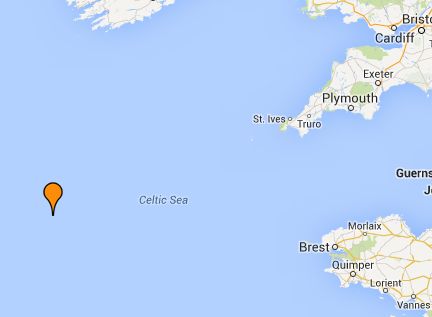

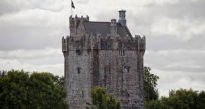

Torpedoed and Sunk in The Western Approaches - 1918
Galway Castle was a 7,988 GRT steam passenger/cargo ship (ref) completed in 1911 by Harland & Wolff Ltd. for Union-Castle Mail Steamship Co. Ltd.
She was sunk on 12 September 1918 by torpedo fired by German submarine U-82 at position 48° 50' N, 10° 40' W - approximately 160 nautical miles South-West by West of Fastnet.
She was en route from London and Plymouth to Port Natal with passengers and a general cargo.
|
Master |
From |
To |
|
T H Wilford |
10/1911 |
10/1913 |
|
B A Bryan |
9/1912 |
|
|
N R Neilson |
3/1913 |
6/1913 |
|
T H Wilford |
2/1914 |
7/1914 |
|
J Culverwell |
11/1913 |
8/1914 |
|
H Strong |
7/1914 |
8/1917 |
|
W B Dyer |
8/1917 |
9/1918 |
At 07.30 hrs on 12th September 1918 when two days out from Plymouth, she was torpedoed by U-82 and broke her back. At the time she was carrying 400 South African walking wounded, 346 passengers and 204 crew members. So severe was the damage that it was thought that she would sink immediately and it was apparent that U-82 was lining up for another attack.
In the rush to abandon ship several lifeboats were swamped by the heavy seas and many finished up in the sea. However, the U-boat did not mount a further attack and the Galway Castle continued to wallow for three days.
Destroyers were summoned by radio to rescue survivors who were taken back to Plymouth where it was ascertained that 143 persons had perished. HMS Spitfire remained in attendance and took off the skeleton crew before she finally sank
Ashore at East London - 1917
Launch of Galway Castle - 1911
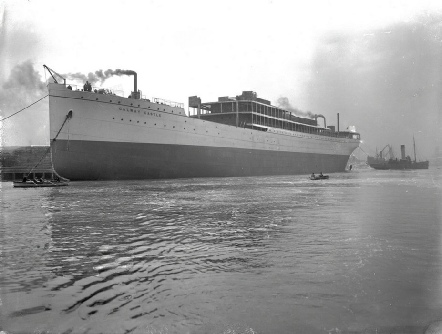
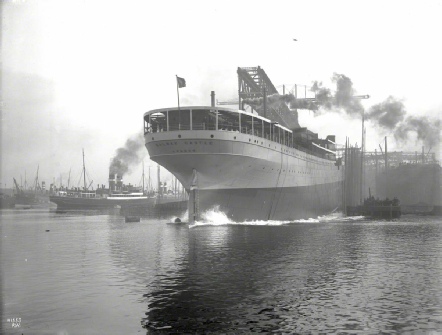 Crew List
Crew List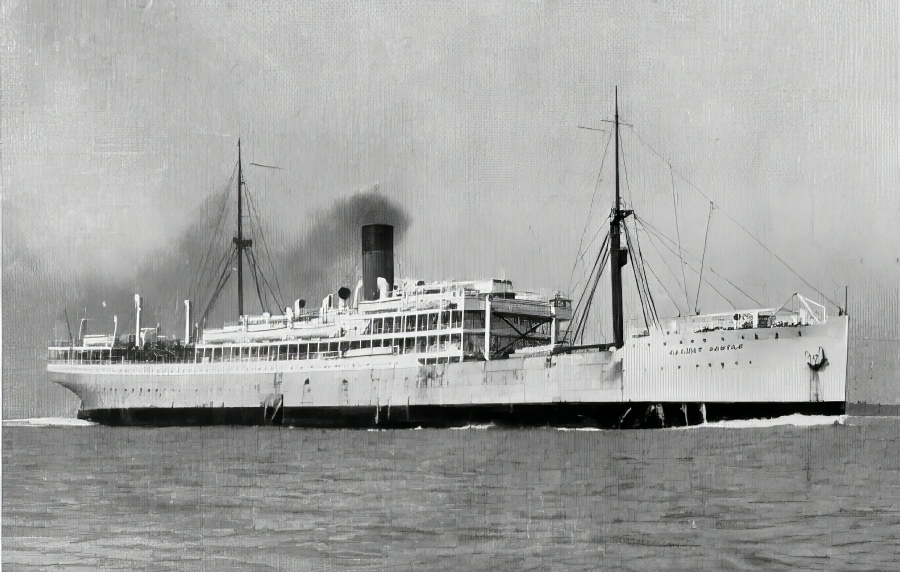
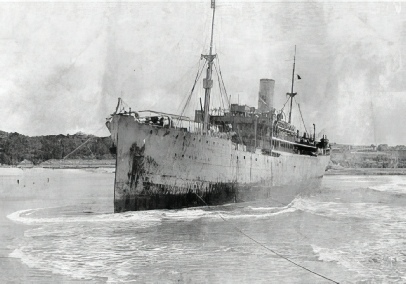
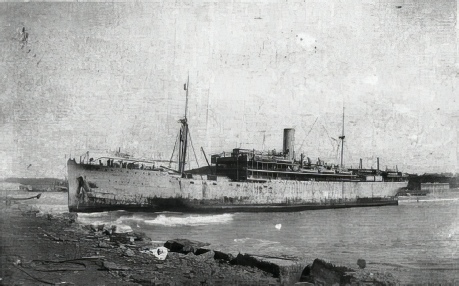
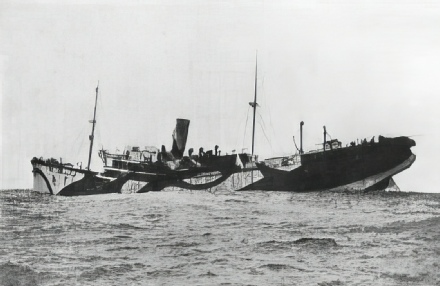
Vessel |
Built |
Tonnage |
Official No |
Ship Builder |
Engine Builder |
Engine Type |
HP |
Screws |
|
Galway Castle |
1911 |
7988 |
132616 |
Harland & Wolff Belfast |
Harland & Wolff Belfast |
2 x Quadruple Expansion Steam |
722 NHP 3750 IHP |
2 |
Career Summary




